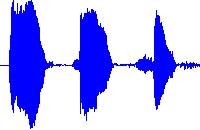
Sound must be digitized before it can be input to a computer. Audio input devices perform this analog to digital conversion.
The following is a plot of the digitized recording of me saying "a b c":

One common audio editing operation is to amplify the sound. Here is the same statement amplified:

Once can select, cut and paste sound, just as in word processing. Here the "a" only; "b c" has been cut out, and I have zoomed in on the time scale to show the fluctuations in more detail:

Here is "a c" without the "b":

Special effect transformations are also common. For example, here is our recording with a delay and echo effect:

The volume envelope may also be varied. Here is a fade out in which the volume diminishes at the end:

This note illustrates only a few audio processing options. Skilled audio engineers are able to cut and paste speech producing completely natural sounding results, identify beats in music for synchronizing sound, reshape sound to make loud and quite passages audible, remove (or insert) background noise, combine independent sound tracks like the dialog and score in a movie, etc,
While these examples are with speech, audio processing programs work with music as well. The examples in this note were created using audacity, an open source audio processing program.